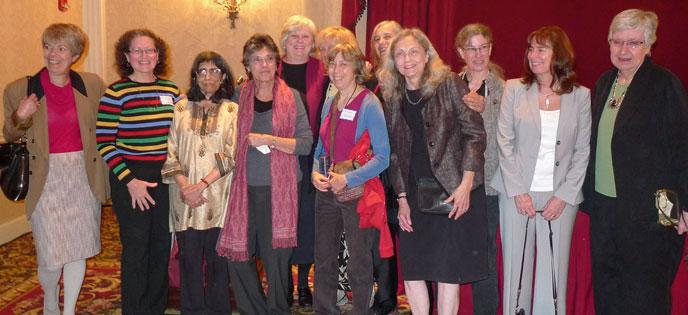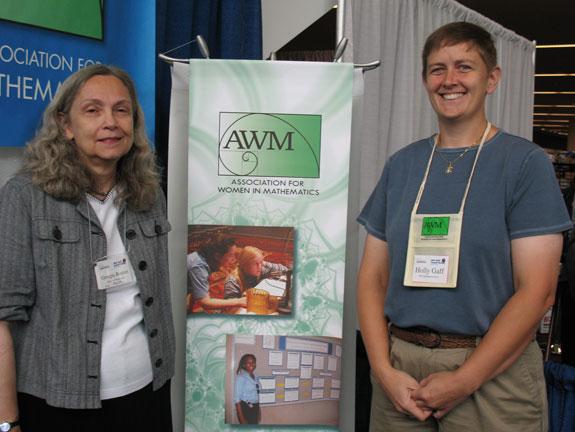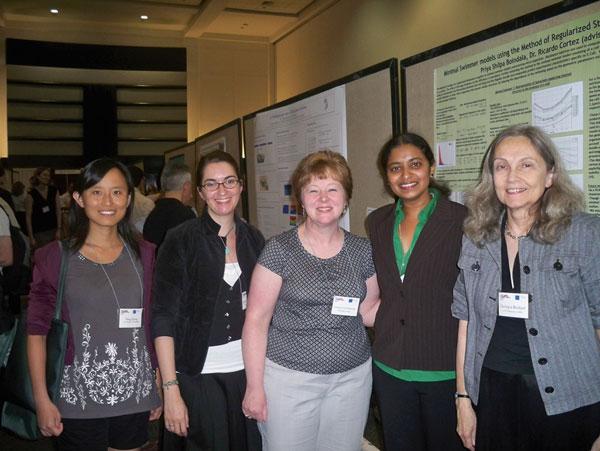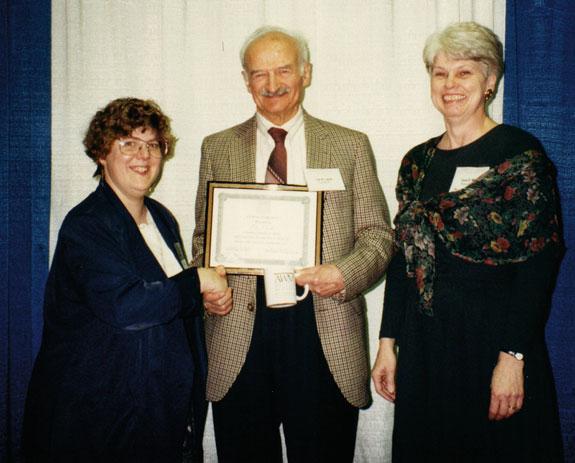by Georgia Benkart

On the occasion of the centennial of the American Mathematical Society in 1988, AMS presented AWM with a silver bowl that has since been passed from the president of AWM to the president-elect at the January Joint Mathematics Meetings (JMM). In January 2009, then-president Cathy Kessel handed the silver bowl and the presidency of AWM to me. The upcoming 50th anniversary of AWM in 2021 caught me by surprise. Was it really that long ago that ideas for the 40th anniversary began to emerge from our conversations with Cathy, her predecessor Barbara Keyfitz, and former presidents Mary Gray, Rhonda Hughes, and Carol Wood? The 40th was a time for reflection and celebration (see Fig. 1), for honoring those who have played a significant role in AWM, for carrying forward their visions and creating new ones, and for welcoming those who will be its future. On this 50th anniversary, it is my hope that the next 50 years will continue these time-honored traditions.

Already underway when I began my term in 2009 were a much-needed overhaul of the AWM website, piloted by Web Editor Holly Gaff (see Fig. 2), assisted by volunteers from Google, and an update of the online application process for AWM workshops and activities, organized by AWM Executive Director Maeve McCarthy. AWM’s 20th anniversary had ushered in a redesign of its newsletter and a new block-letter logo. The current golden-ratio inspired design debuted in the May–June 2009 newsletter. The December 2010 issue marked the first time the newsletter appeared online. Generous funding by Jean Taylor (AWM president 1999–2001) to digitize all of AWM’s newsletters saved early issues from deterioration and made past newsletters accessible to everyone online via the AWM website. What an essential role the newsletter has played in the organization and in keeping women in mathematics connected and informed! Anne Leggett became editor of the AWM Newsletter in 1977 and continues in that role to this day. Words cannot adequately express our deep gratitude for her efforts. Who else could successfully cajole a president’s report for each issue with such mild reminders?
Kristin Lauter (AWM president 2015–2017) and I were invited to speak at the International Conference for Women in Mathematics hosted by the Korean Women in Mathematical Sciences (KWMS) in Seoul in June 2009. The first international joint meeting of the American Mathematical Society and the Korean Mathematical Society was to be held in December of that year at Ewha Womans University, the world’s largest women’s university. In the dual roles of AWM president and of AMS associate secretary for that meeting, I collaborated with KWMS president Wansoon Kim and Kyewon Koh Park to organize the first-ever joint AWM–KWMS event in conjunction with the December meeting. Activities included a panel, Empowering Women Mathematicians for Excellence, featuring Ruth Charney, Jane Hawkins, Heisook Lee, and Hee Oh as panelists. They recounted their own career stories with a healthy dose of advice shared by each, followed by discussion and a banquet.
It was not surprising to learn that women in mathematics in Korea face many of the same challenges as women in the US. Here, one challenge we confront is the stagnation of the percentage of US doctoral degrees in mathematics awarded to women, which has hovered between 25% and 30% for the past 10 years1 Yet another is a recent trend of lawsuits targeting programs designed to address the underrepresentation of particular demographic groups among US mathematicians.
In 2009, the Association for Women in Science (AWIS) received a three-year grant from the National Science Foundation for a new project, Advancing Ways of Awarding Recognition in Disciplinary Societies (or AWARDS for short). Almost all the major US mathematics and statistics societies participated by having their award processes reviewed and evaluated with respect to gender bias. Cathy Kessel and Maura Mast represented AWM (as an AWIS partner), and Charles Epstein, Frank Morgan, and I represented AMS at the AWARDS workshop, where organizations were asked to evaluate their prize procedures. This resulted in revisions of nominating processes, greater clarity in prize criteria, and more awareness of best practices (see Betty Mayfield’s article in this volume). Although there subsequently has been growth in the number of prizes awarded to women, the number is still not representative of the percentages of women who qualify for the prizes. However, AWM’s increase in the number of prizes designated for early-career mathematicians has helped to bring more awareness to their achievements and boost their chances of finding professional opportunities worthy of their talents. Former students of M. Gweneth Humphreys at Randolph-Macon College proposed and funded a new AWM prize to recognize a teacher of undergraduate mathematics (independent of gender) who has had a significant impact on one or more female students through mentoring. The Executive Committee of AWM approved this award in 2009, and in spring 2010 I submitted a formal request on behalf of AWM to the committee managing the Joint Mathematics Meetings that it be added to the other AWM prizes conferred at the Joint Prize Session at the January JMM. The response I received was totally unexpected, especially in light of the AWARDS efforts. The decision was to remove all AWM prizes from the session. After much back and forth, the AWM prizes were reinstated to the session, and the Humphreys award was to be included in future prize sessions. The first M. Gweneth Humphreys Award was presented to Rhonda Hughes (EDGE Program2 co-founder and AWM president 1987–1989) at JMM 2011, one of the many inspiring events that celebrated the 40th anniversary of the founding of AWM.

The AWM Long-range Planning Committee, which had been dormant for almost five years, was resurrected in 2009 and began planning in earnest for AWM’s 40th anniversary. It was decided that there should be enhanced AWM activities at JMM 2011; that the AWM-SIAM workshop and Sonia Kovalevsky lecture should be moved from their usual home at the annual SIAM summer meeting (see Fig. 3) to ICIAM (International Congress on Industrial and Applied Mathematics), as the SIAM meeting was not held that year because of the congress; and that there also should be a stand-alone meeting of AWM apart from JMM and ICIAM. Increasing visibility and building a wider community were at the forefront of these efforts. Events at JMM 2011 included three minisymposia featuring winners of AWM’s Hay, Michler, and Schafer prizes as speakers and a banquet with some fine New Orleans jazz, where Bettye Anne Case, AWM’s longtime meetings coordinator, and Anne Leggett were honored for their exceptional service to AWM.
With deep sadness, AWM had learned that one of its founders and its second president, Alice Schafer, died on September 27, 2009. AWM could not have gotten off the ground without the fearless determination, the unwavering commitment to promoting the equal treatment of all mathematicians, and the boundless energy of its founding mothers, especially Mary Gray, the first president, and Alice Schafer, the second. Alice, who had contributed in countless ways to the organization and to women in mathematics, continued to do so through an extraordinary bequest of \$50,000 that AWM received from her estate. One of the enhanced activities at JMM 2011 was the Schafer Minisymposium, where Mary Gray inaugurated the 40th anniversary celebration with a talk, Life in the Trenches with Alice: The Early Years, a retrospective on the founding of AWM. Alice would have taken great pride in the Schafer Prize winners who spoke in the minisymposium. The mathematical world suffered another immense loss when Cora Sadosky (AWM president 1993–1995) died on December 3, 2010. The AWM business meeting at JMM 2011 was largely devoted to a quickly arranged, heartfelt remembrance of Cora that her colleagues and I organized. Cora was both a strong advocate for women in mathematics, and, as a faculty member at Howard University, an active proponent of the greater participation of African Americans in mathematics. I can only marvel at the tenacity and wisdom of Mary, Alice, Cora, and all who preceded and followed me in this role of president. The 40th anniversary activities at ICIAM 2011, which included an embedded AWM meeting, coincided with the start of Barbara Keyfitz’s term as president of the International Council for Industrial and Applied Mathematics. Barbara (AWM president 2005–2007) became the first woman to assume that role. A reciprocal membership agreement between AWM and SIAM further served to strengthen AWM’s ties with the industrial and applied mathematics communities. In the summer of 2010, SIAM president Douglas Arnold contacted me about the possibility of such an agreement. At the time, only about 15% of SIAM’s members were women, and AWM had few members who worked in industry. The membership agreement he and I hammered out is still in force. With the reduction of academic job opportunities, it will become increasingly important for AWM to reach out to those working in government and industry in order to be fully representative of women in mathematics. A big step in this direction occurred in 2015 when Kristin Lauter, Principal Researcher and Research Manager of the Cryptography Group at Microsoft Research, became AWM’s first president from industry since Jill Mesirov (1989–1991).
AWM’s stand-alone meeting was the grand finale of the 40th anniversary. By some amazing alignment of the planets, the new Institute for Computational and Experimental Research in Mathematics (ICERM) at Brown University had just recently received the good news that it had been chosen to become an NSF-funded institute. It would be open for business starting in 2011, and AWM president-elect Jill Pipher was to be its founding director. Jill, Kristin Lauter, and I organized 40 Years and Counting: AWM’s Celebration of Women in Mathematics, which was held there in September 2011 with enormous help from the ICERM staff, funding from an NSF grant, and additional support from AMS, Brown University, ICERM, MAA, Microsoft Research, Pearson Education, SIAM, and the US Department of Energy. Modeled on AMS sectional meetings, the two-day conference had an attendance of over 300 women and men and featured 4 invited talks, 18 sessions on a wide range of topics in pure and applied mathematics and mathematics education, with a total of 135 speakers. Subsequent stand-alone AWM research symposia have been an excellent way to perpetuate the spirit of this meeting. A day-long retreat at ICERM just prior to the 40th anniversary meeting enabled the AWM Executive Committee to reflect on AWM’s accomplishments, review its programs, and strategically plan for the future. With the graying of societies, renewal of the AWM membership has become a critical issue. Is AWM still relevant? We would like to think the answer is an emphatic “yes,” but what can be done to make AWM more attractive to early-career mathematicians and encourage them to become involved?
Sylvia Bozeman (EDGE Program co-founder and twice an AWM Executive Committee member) provided an insightful answer that resonates yet today in her AWM newsletter article:3
It would be difficult to measure the impact of AWM since it was established in 1971 if we tried. During that period the percentage of women among the US citizens who earned doctorates in mathematics has doubled; there is greater visibility of women on national programs and in professional leadership positions; and more visible attempts have been made to interest young women in mathematics. AWM has addressed each of these areas through its programs. But as long as women are underrepresented in any aspect of the mathematics community, and as long as the reasons for that underrepresentation are not adequately addressed by the larger mathematics community, we will continue to need AWM. As a young and developing organization, it has an opportunity to establish a pattern of involving women from all groups in articulating and addressing issues of common concern. If AWM does not, who will?
Drawing on the enthusiastic response to 40 Years and Counting, AWM developed a series of biennial research symposia. I co-organized the first in the series with Hélène Barcelo, Estelle Basor, Ruth Charney, Frank Farris, and Jill Pipher at Santa Clara University in 2013. The symposium featured plenary talks by three distinguished mathematicians: Inez Fung, Professor of Atmospheric Sciences at UC Berkeley and an expert on the mathematics of climate; the late Maryam Mirzakhani, 2014 Fields Medalist; and Lauren Williams, the Dwight Parker Robinson Professor of Mathematics at Harvard University and the Sally Starling Seaver Professor at the Radcliffe Institute (as of 2020). There were also invited and contributed sessions on a wide range of subjects in pure and applied mathematics, a poster session for graduate students, and a discussion of the imposter syndrome moderated by Hélène Barcelo with panelists Ruth Charney, Brian Conrey, Jill Pipher, and Carol Wood. A persistent problem that discourages women from pursuing careers in mathematics, lack of confidence is common for both men and women during the development of their careers. Yet women are more likely to feel their self-doubts are unique and to give up as a result. The panel consequently was designed to show younger women that even some of the most successful, well-established women and men in the field have had, and may often still have, similar feelings of being “an imposter” and not deserving of the status they have attained.
One attendee wrote, “This event was a magnificent experience for me. I am so glad that AWM is doing this, and I’ll make sure to tell the other women in my department about what a fantastic opportunity these are.” AWM was grateful for the financial support from Santa Clara University, NSF, NSA, and the institutes AIM, ICERM, and MSRI that enabled this meeting to launch the highly successful series of AWM research symposia.
During my term, AWM made a concerted effort to widen its outreach with such activities as participation in the inaugural USA Science and Engineering Festival in October 2010. This was spearheaded by Executive Committee member Irina Mitrea, co-organizers Tai Melcher and Katharine Ott, and a phenomenal group of undergraduate student volunteers from universities in the Washington, DC, area. With few resources, the group created activities involving cryptography and ciphers, such as Thomas Jefferson’s wheel cipher used during his presidency for encoding diplomatic secrets, to test the skills of participants young and old and to inspire girls to get excited about mathematics. Participation in this festival event in even-numbered years and in the National Mathematics Festival in odd-numbered ones has since become an important AWM proactive tradition. In 1993, AWM president Cora Sadosky noted the many gains already achieved by the association as it was about halfway to the milestone we now celebrate. But then she added:
Still, women continue to face formidable problems in their development as mathematicians — from elementary school to graduate school to the National Academy and beyond. To successfully confront these problems, we need the ideas and the work, the enthusiasm and the commitment of all — students and teachers and researchers and industrial mathematicians — of every woman and every man who stands for women’s right to mathematics.4

Over the years, men such as Chandler Davis and Lee Lorch have been dedicated and loyal allies who have given moral and financial support to AWM. Indeed, a nontrivial percentage of AWM’s members are men. At his retirement conference in 1992, Chandler was presented an AWM mug, and Cora Sadosky, president-elect of AWM, sent a message from Barcelona:
While our founding mothers were creating AWM, 21 years ago, Chandler was at their side. […] It has given all of us who have the joyous privilege of his counsel and criticism, the opportunity to learn how one can be at the same time level-headed and uncompromising, patient and ardent, tolerant and unyielding.5
At the JMM in 1992, AWM made a surprise presentation of a citation to Lee for his efforts as a champion of human rights (see Fig. 4):
To Lee Lorch, a founding member of AWM, with thanks for his activism on behalf of women and minority mathematicians. Lee has often been a thorn in the side of the mathematics establishment. But then, to its credit, so has AWM…When AWM helped to open up the AMS Council to petition candidates, Lee was elected and pushed tirelessly on issues of special concern to women and minority mathematicians.6
It was wonderful to recognize Lee Lorch again in 2010, on the occasion of his 95th birthday, with a special newsletter remembrance.7 Throughout his career, he was an unflagging advocate for educational opportunities for women and underrepresented minorities. Vivienne Malone Mayes, an undergraduate student of Lorch at Fisk University whom he encouraged to pursue doctoral studies in mathematics, was the first Black person elected to AWM’s Executive Committee.
AWM has been a force for positive change and an effective voice on behalf of the advancement of women in the mathematical professions. With only a few paid staff members, AWM exists and thrives because of the extraordinary dedication of its thousands of volunteers who have committed time and energy to AWM over its 50 years of existence. I am honored to be counted as one of those thousands.